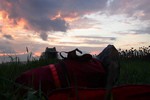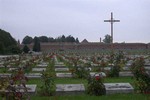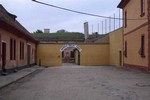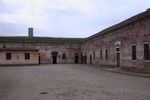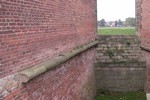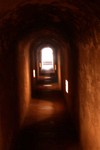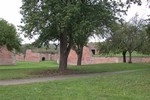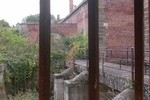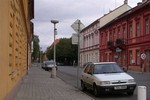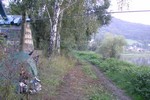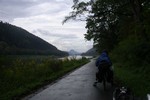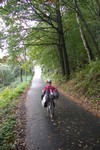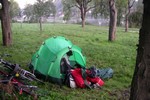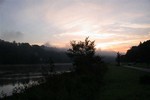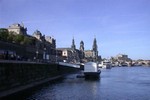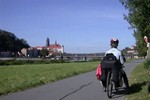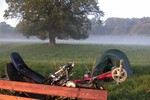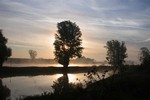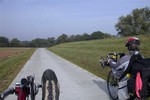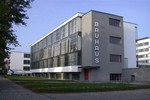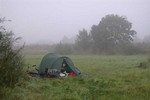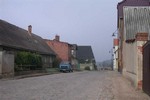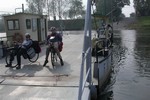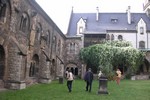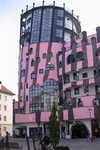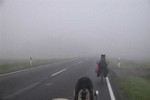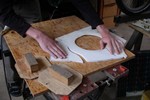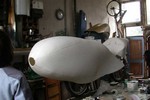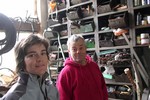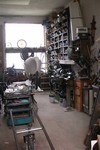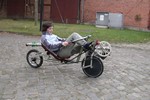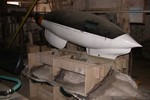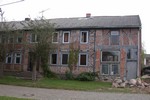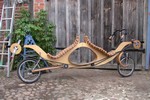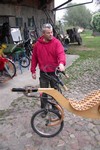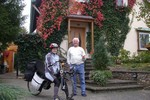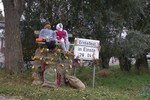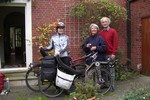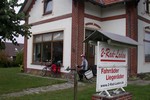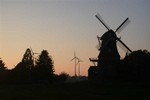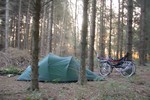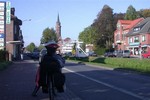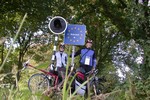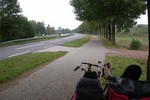Cycling from Prague (CZ) to Meppel (NL)
5th-19th of October 2006
From the suburbs of Prague, we cycled 1074 km to Meppel. We cycled on recumbents, an M5 28/26 and a Natrix2. The first half we cycled along the Elberadweg. Already from Lovosice in Czech Republic we started to cycle along the Elbe, which is called Labe in Czech. After leaving the Elbe in Magdeburg we chose our own route along friends in the north of Germany and The Netherlands.
The first evening we found a nice spot in a meadow next to a sunflower field. We wondered if it wasn't time to harvest the sunflowers. We didn't need to doubt long, half of hour later a big combine past us...
The next day we visited the former World War II Nazi concentration camp Terezín (Theresienstadt). It consists of two fortresses, the Main Fortress and the Small Fortress. This is the cemetery in front of the Small Fortress.
After three prisoners managed to escape the Nazis damaged the stone moulding to avoid recurrence. Also they murdered a few prisoners as a warning for the other prisoners.
The Small Fortress contains many kilometers of tunnel. This one was 500 m long. During the Nazi occupation, the tunnels were closed, to avoid that prisoners would use it to escape.
The Main Fortress is still inhabited by people. Also the Ghetto Museum can be found there.
Cyclepath on the south side of the Elbe, near the Basteibrücke, which is a stone brigde between the rocks on the north side.
The Bauhaus in Dessau is an art, design and architecture school in Germany that was founded in Weimar in 1919 and existed till 1933. It was of great importance for the development of design and archictecture.
The Magdeburger Dom in ... Magdeburg.
The 'Grüne Zitadelle' is a building from architect Hundertwasser in Magdeburg.
The next day was very foggy during the whole day, although in the end of the day we could see a few hundert meter far. This is in the morning near Haldensleben.
We visited our friend Axel Ewen in a small village near Salzwedel. In his workshop, we tried his foam cutting and welding machine. The cutting of the foam goes very easy. The small sheet of metal that's used for cutting is connected to a cheap welding pistol, which is hanging under the sheet of wood.By pressing two pieces of foam together along the hot metal sheet, the foam is welded together again.
Axel has built many recumbents in his workshop. In the foreground one of his current projects can be seen, a side-by-side-back-to-back tandem (4 cyclists, 2 wheels...).
Evina is testing one of Axels recumbents. This one has a frontfork an rearfork from a Birdy foldingbike.
In one of the barns close to Axels house this fairing was stored together with the original mould. It's called 'the pinguin' and it was the graduation project of Frank Lienhard, carried out together with Mercedes. The bicycle used linear drive.
Axels plywood back-to-back tandem. It is a sandwich of 2 mm thick plywood and 40 mm thick cork. It's fully suspended using laminated wood and damped with rubber.
Axel recommended us to ask a cycling couple in Soltau if we could spend the night in their house. They are one of the 2500 adresses which can be found in the ADFC-Dachgeber book. As a member of the ADFC-Dachgeber initiative you can offer lodging for free to cyclists and use the roof of other members when you travel yourself.
Coincidentally we passed the recumbent shop '2-Rad-Laden' in Bassum.
Approximately 100 km from the border it became noticable that we were getting closer to The Netherlands. For example because of this type of windmill.

